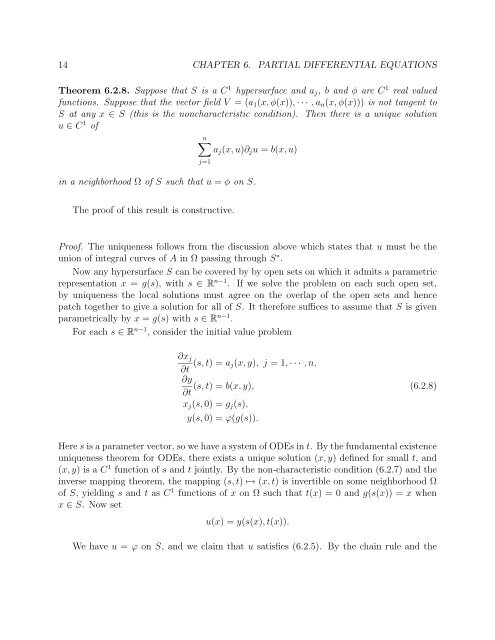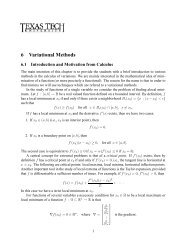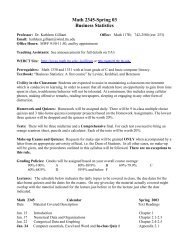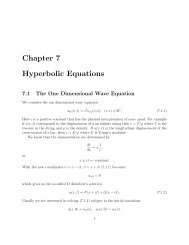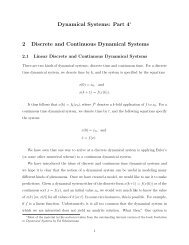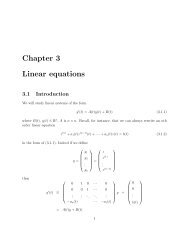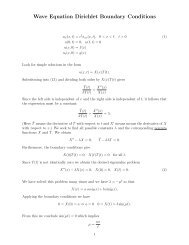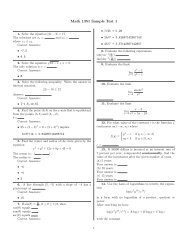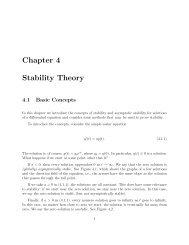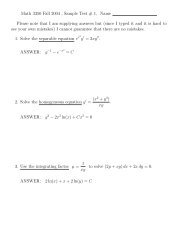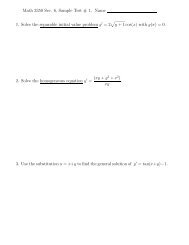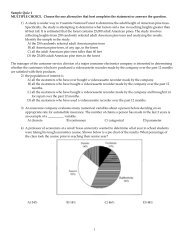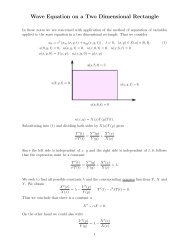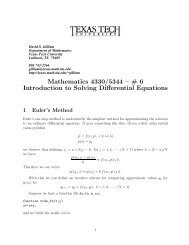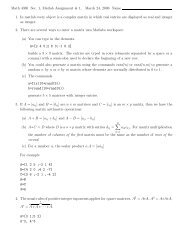Chapter 6 Partial Differential Equations
Chapter 6 Partial Differential Equations
Chapter 6 Partial Differential Equations
Create successful ePaper yourself
Turn your PDF publications into a flip-book with our unique Google optimized e-Paper software.
14 CHAPTER 6. PARTIAL DIFFERENTIAL EQUATIONS<br />
Theorem 6.2.8. Suppose that S is a C 1 hypersurface and a j , b and φ are C 1 real valued<br />
functions. Suppose that the vector field V =(a 1 (x, φ(x)), ··· ,a n (x, φ(x))) is not tangent to<br />
S at any x ∈ S (this is the noncharacteristic condition). Then there is a unique solution<br />
u ∈ C 1 of<br />
n∑<br />
a j (x, u)∂ j u = b(x, u)<br />
j=1<br />
in a neighborhood Ω of S such that u = φ on S.<br />
The proof of this result is constructive.<br />
Proof. The uniqueness follows from the discussion above which states that u must be the<br />
union of integral curves of A in Ω passing through S ∗ .<br />
Now any hypersurface S can be covered by by open sets on which it admits a parametric<br />
representation x = g(s), with s ∈ R n−1 . If we solve the problem on each such open set,<br />
by uniqueness the local solutions must agree on the overlap of the open sets and hence<br />
patch together to give a solution for all of S. It therefore suffices to assume that S is given<br />
parametrically by x = g(s) with s ∈ R n−1 .<br />
For each s ∈ R n−1 , consider the initial value problem<br />
∂x j<br />
∂t (s, t) =a j(x, y), j=1, ··· ,n,<br />
∂y<br />
(s, t) =b(x, y), (6.2.8)<br />
∂t<br />
x j (s, 0) = g j (s),<br />
y(s, 0) = ϕ(g(s)).<br />
Here s is a parameter vector, so we have a system of ODEs in t. By the fundamental existence<br />
uniqueness theorem for ODEs, there exists a unique solution (x, y) defined for small t, and<br />
(x, y) isaC 1 function of s and t jointly. By the non-characteristic condition (6.2.7) and the<br />
inverse mapping theorem, the mapping (s, t) ↦→ (x, t) is invertible on some neighborhood Ω<br />
of S, yielding s and t as C 1 functions of x on Ω such that t(x) =0andg(s(x)) = x when<br />
x ∈ S. Now set<br />
u(x) =y(s(x),t(x)).<br />
We have u = ϕ on S, and we claim that u satisfies (6.2.5). By the chain rule and the


